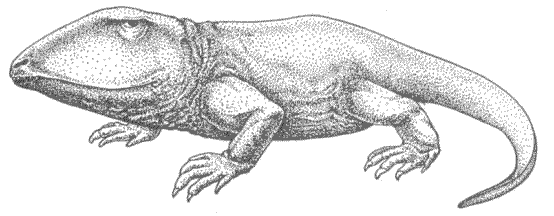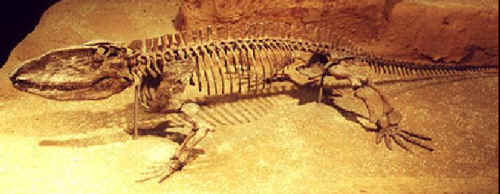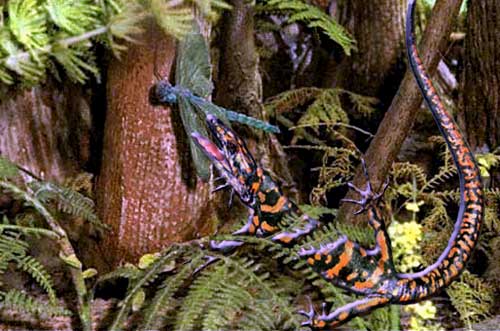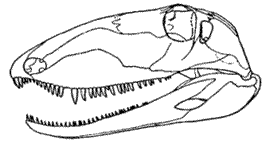
| Palaeos |  |
Synapsida |
| Vertebrates | Ophiacodontidae |
| Page Back | Unit Home | Unit Dendrogram | Unit References | Taxon Index | Page Next |
| Unit Back | Vertebrates Home | Vertebrate Dendrograms | Vertebrate References | Glossary | Unit Next |
Abbreviated Dendrogram
AMNIOTA | SYNAPSIDA |--Caseasauria | |--Eothyrididae | `--Caseidae `--Eupelycosauria |--Varanopseidae `--+--Ophiacodontidae | |--Archaeothyris | `--Ophiacodon `--+--Edaphosauridae `--Sphenacodontia `==Sphenacodontidae `--THERAPSIDA |
Contents
Index |
 Ophiacodontids
include small to very large carnivorous pelycosaurs distinguished by certain
specialized cranial features. These were possibly semi-aquatic or fully
aquatic animals, appearing early in the Carboniferous coal swamps.
Ophiacodontids
include small to very large carnivorous pelycosaurs distinguished by certain
specialized cranial features. These were possibly semi-aquatic or fully
aquatic animals, appearing early in the Carboniferous coal swamps.
There is a curious tendency to increase in the skull to trunk ratio, larger taxa having unusually large, awkward looking, elongate skulls. These animals also have relatively large, massive shoulder girdles, possibly to provide muscle attachment to support the weight of the huge head.
The modern cladistic paradigm unites ophiacodontids, edaphosaurids, and sphenacodontids by the possession of certain specialized features of the skull. However this is also the oldest family of pelycosaurs, and indeed of Synapsids/Theropsids, with the oldest known pelycosaurs - Protoclepsydrops and Archaeothyris - being included in this family (the former tentatively, the latter definitely).
From an ophiacodont stem, pelycosaurs evolved in two directions. One line of pelycosaurian development led to large aggressive, land-living carnivores, the sphenacodontids, the other to large plant- eating forms, the edaphosaurs. The ophaicodonts and edaphosaurs died out with the drying out of their swamp and pond-margin environments during the middle Permian, the sphenacodontids continued on a bit longer. (MAK 000720)
 Ophiacodontidae: Protoclepsydrops?
Ophiacodontidae: Protoclepsydrops?
Range: Pennsylvanian [RB86] to Guadalupian of North America & ?Europe
Phylogeny: Eupelycosauria :: (Edaphosauridae + Sphenacodontia) + * : Archaeothyris + Ophiacodon.
Characters: Semi-aquatic piscivores (per Romer. Reisz disagrees, based on the awkward length and height of the skull). Up to 4m. Head long & slender; deep jaw; numerous (40+) small teeth; well-developed lateral mandibular fenestra in notch of dentary; posterodorsal processes of premaxillae are long, thin & separated at midline by anterior process of nasal; angular with well developed ventral keel; lingual maxillary buttress above canines; $ antorbital skull at least twice as long as postorbital skull; $ nasal longer than frontal (at least twice as long as parietal); lacrimal elongated; orbit high on skull; ventral edge of skull concave postorbitally & includes jugal; relatively low skull table; braincase elements less fused than in other eupelycosaurs; $ paroccipital process short, not extending to the cheek long tail; tabular with large medial process; dorsal centra relatively shorter than in sphenacodonts and edaphosaurids [RP40]; pectoral girdles large and massive; particularly broad anterior of scapulocoracoid; carpals & tarsals poorly ossified; claws blunted? absent?. Includes oldest known synapsid (Protoclepsydrops).
Image: Ophiacodon from The Synapsid Story (Ben Waggoner lecture)
Links: Paleontology and Geology Glossary: V; Synapsida; Biology 356. Schnellbestimmung anhand von typischen Schädelmerkmalen; Lecture 03 - Cont. Drift; Ophiacodontidae (Mikko's Phylogeny); Ophiacodon (German: interesting reconstruction); Ophiacodon, a pelycosaur with no fin.
References: Reisz & Berman (1986) [RB86]; Romer & Price (1940) [RP40]. ATW081024.
 Archaeothyris:
A. florensis. The oldest undisputed synapsid.
Archaeothyris:
A. florensis. The oldest undisputed synapsid.
Range: Pennsylvanian (Kasimovian, possibly Moscovian) of North America (Nova Scotia) [TH04]
Phylogeny: Ophiacodontidae: Ophiacodon + *.
Characters: "true" synapsid skull
Introduction: Protoclepsydrops from the Middle Pennsylvanian of Joggins, Nova Scotia has been placed within the Ophiacodontidae, but its identity and taxonomic status is uncertain, partly because the known skeletal remains are fragmentary. Archaeothyris, from slightly younger sediments near Florence, Nova Scotia, is the oldest known diagnosable ophiacodontid. This was a more advanced animal than the contemporary protorothyrid captorhinomorphs. Its jaws were strong, and could be opened wide and snapped shut. Although its teeth were all the same shape - sharp and pointed - they were of different sizes, including a large pair of canines at the front of the jaws. Such teeth suggest a varied, carnivorous diet, and area distinguishing mark of the carnivorous pelycosaurs. MAK
References: van Tuinen & Hadly (2004) [TH04].
 |
Ophiacodon: Early Permian of North America (Texas). Size: 1.5 to 2.5 meters, maximum size up to 3.6m long. |
Range: Early Permian of North America
Phylogeny: Ophiacodontidae: Archaeothyris + *.
Introduction: Ophiacodon, a large Permian synapsid commonly 1.5 to 2.5 meters in length, was a specialized member of the ophaicodontid lineage. It is also the best known member of the family, represented by an extensive fossil record in North America, that has been subdivided, somewhat arbitrarily (based largely on stratigraphic position and size) into six species. The skull was very deep, with long jaws, these being provided with many sharp teeth. It has often been suggested that Ophiacodon was a fish-eating animal that lived largely along the shores of streams and ponds, although the high narrow skull would seem to mitigate against such a lifestyle. MAK
| Page Back | Unit Home | Page Top | Page Next |
checked ATW050112